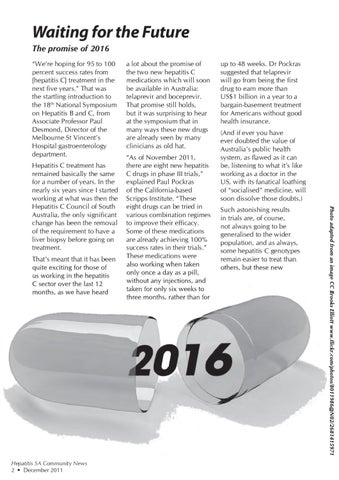Waiting for the Future The promise of 2016 “We’re hoping for 95 to 100 percent success rates from [hepatitis C] treatment in the next five years.” That was the startling introduction to the 18th National Symposium on Hepatitis B and C, from Associate Professor Paul Desmond, Director of the Melbourne St Vincent’s Hospital gastroenterology department. Hepatitis C treatment has remained basically the same for a number of years. In the nearly six years since I started working at what was then the Hepatitis C Council of South Australia, the only significant change has been the removal of the requirement to have a liver biopsy before going on treatment. That’s meant that it has been
Hepatitis SA Community News 2 • December 2011
a lot about the promise of the two new hepatitis C medications which will soon be available in Australia: telaprevir and boceprevir. That promise still holds, but it was surprising to hear at the symposium that in many ways these new drugs are already seen by many clinicians as old hat. “As of November 2011, there are eight new hepatitis C drugs in phase III trials,” explained Paul Pockras of the California-based Scripps Institute. “These eight drugs can be tried in various combination regimes to improve their efficacy. Some of these medications are already achieving 100% success rates in their trials.” These medications were
up to 48 weeks. Dr Pockras suggested that telaprevir will go from being the first drug to earn more than US$1 billion in a year to a bargain-basement treatment for Americans without good health insurance. (And if ever you have ever doubted the value of Australia’s public health system, as flawed as it can be, listening to what it’s like working as a doctor in the US, with its fanatical loathing of “socialised” medicine, will soon dissolve those doubts.) Such astonishing results in trials are, of course, not always going to be generalised to the wider population, and as always, some hepatitis C genotypes remain easier to treat than
